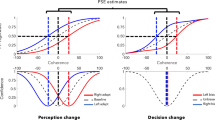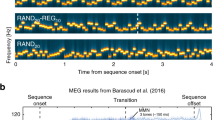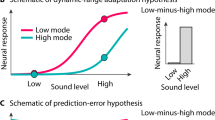Abstract
Prior expectations can be used to improve perceptual judgments about ambiguous stimuli. However, little is known about whether and how these improvements are maintained in dynamic environments in which the quality of appropriate priors changes from one stimulus to the next. Here we use a sound-localization task to show that changes in stimulus predictability lead to arousal-mediated adjustments in the magnitude of prior-driven biases that optimize perceptual judgments about each stimulus. These adjustments depend on task-dependent changes in the relevance and reliability of prior expectations, which subjects update using both normative and idiosyncratic principles. The resulting variations in biases across task conditions and individuals are reflected in modulations of pupil diameter, such that larger stimulus-evoked pupil responses correspond to smaller biases. These results suggest a notable role for the arousal system in adjusting the strength of perceptual biases with respect to inferred environmental dynamics to optimize perceptual judgements.
This is a preview of subscription content, access via your institution
Access options
Access Nature and 54 other Nature Portfolio journals
Get Nature+, our best-value online-access subscription
$29.99 / 30 days
cancel any time
Subscribe to this journal
Receive 12 digital issues and online access to articles
$119.00 per year
only $9.92 per issue
Buy this article
- Purchase on Springer Link
- Instant access to full article PDF
Prices may be subject to local taxes which are calculated during checkout








Similar content being viewed by others
References
Bar, M. Visual objects in context. Nat. Rev. Neurosci. 5, 617–629 (2004).
Edwards, W. Optimal strategies for seeking information: models for statistics, choice reaction times, and human information processing. J. Math. Psychol. 2, 312–329 (1965).
Link, S. W. & Heath, R. A. A sequential theory of psychological discrimination. Psychometrika 40, 77–105 (1975).
Maddox, W. T. & Bohil, C. J. Base-rate and payoff effects in multidimensional perceptual categorization. J. Exp. Psychol. Learn Mem. Cogn. 24, 1459–1482 (1998).
Seriès, P. & Seitz, A. R. Learning what to expect (in visual perception). Front. Hum. Neurosci. 7, 668 (2013).
Summerfield, C. & Egner, T. Expectation (and attention) in visual cognition. Trends Cogn. Sci. 13, 403–409 (2009).
Fischer, B. J. & Peña, J. L. Owl’s behavior and neural representation predicted by Bayesian inference. Nat. Neurosci. 14, 1061–1066 (2011).
Knill, D. C. & Pouget, A. The Bayesian brain: the role of uncertainty in neural coding and computation. Trends Neurosci. 27, 712–719 (2004).
Stocker, A. A. & Simoncelli, E. P. Noise characteristics and prior expectations in human visual speed perception. Nat. Neurosci. 9, 578–585 (2006).
Nassar, M. R., Wilson, R. C., Heasly, B. & Gold, J. I. An approximately Bayesian delta-rule model explains the dynamics of belief updating in a changing environment. J. Neurosci. 30, 12366–12378 (2010).
Nassar, M. R. et al. Rational regulation of learning dynamics by pupil-linked arousal systems. Nat. Neurosci. 15, 1040–1046 (2012).
Knill, D. C & Richards, W. Perception as Bayesian Inference (Cambridge Univ. Press, 1996).
Wilson, R. C., Nassar, M. R. & Gold, J. I. Bayesian online learning of the hazard rate in change-point problems. Neural Comput. 22, 2452–2476 (2010).
Bouret, S. & Sara, S. J. Network reset: a simplified overarching theory of locus coeruleus noradrenaline function. Trends Neurosci. 28, 574–582 (2005).
Ullsperger, M., Harsay, H. A., Wessel, J. R. & Ridderinkhof, K. R. Conscious perception of errors and its relation to the anterior insula. Brain Struct. Funct. 214, 629–643 (2010).
Harley, C. W. Norepinephrine and the dentate gyrus. Prog. Brain Res. 163, 299–318 (2007).
Yu, A. J. & Dayan, P. Uncertainty, neuromodulation, and attention. Neuron 46, 681–692 (2005).
Aston-Jones, G. & Cohen, J. D. An integrative theory of locus coeruleus-norepinephrine function: adaptive gain and optimal performance. Annu. Rev. Neurosci. 28, 403–450 (2005).
Joshi, S., Li, Y., Kalwani, R. M. & Gold, J. I. Relationships between pupil diameter and neuronal activity in the locus coeruleus, colliculi, and cingulate cortex. Neuron 89, 221–234 (2016).
Adams, W. J., Graf, E. W. & Ernst, M. O. Experience can change the ‘light-from-above’ prior. Nat. Neurosci. 7, 1057–1058 (2004).
Berniker, M., Voss, M. & Kording, K. Learning priors for Bayesian computations in the nervous system. PLoS ONE 5, e12686 (2010).
Burge, J., Ernst, M. O. & Banks, M. S. The statistical determinants of adaptation rate in human reaching. J. Vis. 8, 20 (2008).
Tassinari, H. & Hudson, T. E. & Landy, M. S. Combining priors and noisy visual cues in a rapid pointing task. J. Neurosci. 26, 10154–10163 (2006).
Stanovich, K. E. & West, R. F. Individual differences in reasoning: implications for the rationality debate? Behav. Brain Sci. 23, 645–726 (2000).
Behrens, T. E. J., Woolrich, M. W., Walton, M. E. & Rushworth, M. F. S. Learning the value of information in an uncertain world. Nat. Neurosci. 10, 1214–1221 (2007).
Wilson, R. C., Nassar, M. R. & Gold, J. I. A mixture of delta-rules approximation to bayesian inference in change-point problems. PLoS Comput. Biol. 9, e1003150 (2013).
Preuschoff, K. Pupil dilation signals surprise: evidence for noradrenaline’s role in decision making. Front. Neurosci. 5, 115 (2011).
Tenenbaum, J. B., Kemp, C. & Griffiths, T. L. How to grow a mind: statistics, structure, and abstraction. Science 331, 1279–1285 (2011).
Vapnik, V. The Nature of Statistical Learning Theory (Springer Science & Business Media, 2013).
Adams, R. P. & MacKay, D. J. C. Bayesian online changepoint detection. Preprint at https://arxiv.org/abs/0710.3742 (2007).
Mathys, C . Daunizeau, J ., Friston, K. J. & Stephan, K. E . A Bayesian foundation for individual learning under uncertainty. Front. Hum. Neurosci. 5, 39 (2011).
Payzan-LeNestour, E. & Bossaerts, P. Risk, unexpected uncertainty, and estimation uncertainty: Bayesian learning in unstable settings. PLoS Comput. Biol. 7, e1001048 (2011).
Preuschoff, K. & Bossaerts, P. Adding prediction risk to the theory of reward learning. Ann. NY Acad. Sci. 1104, 135–146 (2007).
Gold, J. I., Law, C. T., Connolly, P. & Bennur, S. The relative influences of priors and sensory evidence on an oculomotor decision variable during perceptual learning. J. Neurophysiol. 100, 2653–2668 (2008).
Jones, M., Curran, T., Mozer, M. C. & Wilder, M. H. Sequential effects in response time reveal learning mechanisms and event representations. Psychol. Rev. 120, 628–666 (2013).
Zhang, S ., Huang, H & Angela, J. Y. Sequential effects: a Bayesian analysis of prior bias on reaction time and behavioral choice. In Proc. 36th Annual Conference of the Cognitive Science Society (eds Bello, P., Guarini, M., McShane, M. & Scassellati B.) (CogSci, 2014).
de Gee, J. W., Knapen, T. & Donner, T. H. Decision-related pupil dilation reflects upcoming choice and individual bias. Proc. Natl Acad. Sci. USA 111, E618–E625 (2014).
Urai, A. E., Braun, A. & Donner, T. H. Pupil-linked arousal is driven by decision uncertainty and alters serial choice bias. Nat. Commun. 8, 14637 (2017).
Frank, M. J. & Badre, D. Mechanisms of hierarchical reinforcement learning in corticostriatal circuits 1: computational analysis. Cereb. Cortex 22, 509–526 (2012).
Collins, A. G. E. & Frank, M. J. Cognitive control over learning: creating, clustering, and generalizing task-set structure. Psychol. Rev. 120, 190–229 (2013).
Eldar, E., Cohen, J. D. & Niv, Y. The effects of neural gain on attention and learning. Nat. Neurosci. 16, 1146–1153 (2013).
Eldar, E., Niv, Y. & Cohen, J. D. Do you see the forest or the tree? Neural gain and breadth versus focus in perceptual processing. Psychol. Sci. 27, 1632–1643 (2016).
Pfaff, D. W. Brain Arousal and Information Theory (Harvard Univ. Press, 2006).
Sara, S. J. & Bouret, S. Orienting and reorienting: the locus coeruleus mediates cognition through arousal. Neuron 76, 130–141 (2012).
Servan-Schreiber, D., Printz, H. & Cohen, J. D. A network model of catecholamine effects: gain, signal-to-noise ratio, and behavior. Science 249, 892–895 (1990).
Kepecs, A., Uchida, N., Zariwala, H. A. & Mainen, Z. F. Neural correlates, computation and behavioural impact of decision confidence. Nature 455, 227–231 (2008).
Kiani, R. & Shadlen, M. N. Representation of confidence associated with a decision by neurons in the parietal cortex. Science 324, 759–764 (2009).
Persaud, N., McLeod, P. & Cowey, A. Post-decision wagering objectively measures awareness. Nat. Neurosci. 10, 257–261 (2007).
Jepma, M. & Nieuwenhuis, S. Pupil diameter predicts changes in the exploration–exploitation trade-off: evidence for the adaptive gain theory. J. Cogn. Neurosci. 23, 1587–1596 (2011).
Lempert, K. M., Chen, Y. L. & Fleming, S. M. Relating pupil dilation and metacognitive confidence during auditory decision-making. PLoS ONE 10, e0126588 (2015).
Satterthwaite, T. D. et al. Dissociable but inter-related systems of cognitive control and reward during decision making: evidence from pupillometry and event-related fMRI. Neuroimage 37, 1017–1031 (2007).
Wessel, J. R., Danielmeier, C. & Ullsperger, M. Error awareness revisited: accumulation of multimodal evidence from central and autonomic nervous systems. J. Cogn. Neurosci. 23, 3021–3036 (2011).
Manohar, S. G. & Husain, M. Reduced pupillary reward sensitivity in Parkinson’s disease. NPJ Parkinsons Dis. 1, 15026 (2015).
Robbins, T. W. & Everitt, B. J. Arousal Systems and Attention (MIT Press, 1995).
Bouret, S. & Richmond, B. J. Sensitivity of locus ceruleus neurons to reward value for goal-directed actions. J. Neurosci. 35, 4005–4014 (2015).
Nieuwenhuis, S., De Geus, E. J. & Aston-Jones, G. The anatomical and functional relationship between the P3 and autonomic components of the orienting response. Psychophysiology 48, 162–175 (2011).
Mather, M., Clewett, D., Sakaki, M. & Harley, C. W. Norepinephrine ignites local hot spots of neuronal excitation: how arousal amplifies selectivity in perception and memory. Behav. Brain Sci. 39, e200 (2016).
Yu, A. J. Change is in the eye of the beholder. Nat. Neurosci. 15, 933–935 (2012).
Reimer, J. et al. Pupil fluctuations track rapid changes in adrenergic and cholinergic activity in cortex. Nat. Commun. 7, 13289 (2016).
Nichols, T. E. & Holmes, A. P. Nonparametric permutation tests for functional neuroimaging: a primer with examples. Hum. Brain Mapp. 15, 1–25 (2002).
Acknowledgements
We thank A.-A. Stoica and N. Kabir for aiding in data collection, L. Ding and T. Doi for helpful comments. This work was funded by NIH grants F32 MH102009 (M.R.N.) and R01 EY015260 and NSF 1533623 (J.I.G.). The funders had no role in study design, data collection and analysis, decision to publish or preparation of the manuscript.
Author information
Authors and Affiliations
Contributions
All authors designed the experiment and analyses and wrote the manuscript, K.K. collected the data, and K.K. and M.R.N. analysed the data.
Corresponding author
Ethics declarations
Competing interests
The authors declare no competing interests.
Supplementary information
Supplementary Information
Supplementary Figures 1–3 (PDF 146 kb)
Rights and permissions
About this article
Cite this article
Krishnamurthy, K., Nassar, M., Sarode, S. et al. Arousal-related adjustments of perceptual biases optimize perception in dynamic environments. Nat Hum Behav 1, 0107 (2017). https://doi.org/10.1038/s41562-017-0107
Received:
Accepted:
Published:
DOI: https://doi.org/10.1038/s41562-017-0107
This article is cited by
-
Pupil diameter as an indicator of sound pair familiarity after statistically structured auditory sequence
Scientific Reports (2024)
-
Spatiotemporal dynamics of noradrenaline during learned behaviour
Nature (2022)
-
Regulation of evidence accumulation by pupil-linked arousal processes
Nature Human Behaviour (2019)
-
Pupil-linked phasic arousal evoked by violation but not emergence of regularity within rapid sound sequences
Nature Communications (2019)
-
An integrative framework for perceptual disturbances in psychosis
Nature Reviews Neuroscience (2019)



